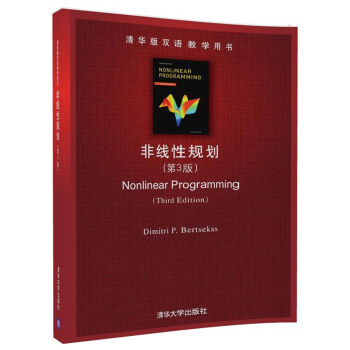

具体描述
内容简介
本书涵盖非线性规划的主要内容,包括无约束优化、凸优化、拉格朗日乘子理论和算法、对偶理论及方法等,包含了大量的实际应用案例. 本书从无约束优化问题入手,通过直观分析和严格证明给出了无约束优化问题的*优性条件,并讨论了梯度法、牛顿法、共轭方向法等基本实用算法. 进而本书将无约束优化问题的*优性条件和算法推广到具有凸集约束的优化问题中,进一步讨论了处理约束问题的可行方向法、条件梯度法、梯度投影法、双度量投影法、近似算法、流形次优化方法、坐标块下降法等. 拉格朗日乘子理论和算法是非线性规划的核心内容之一,也是本书的重点.
精彩书摘
Optimization over a Convex Set
Contents
3.1.ConstrainedOptimizationProblems.........p.2363.1.1.NecessaryandSu.cientConditionsforOptimality.p.2363.1.2.ExistenceofOptimalSolutions.........p.246
3.2.FeasibleDirections-ConditionalGradientMethod..p.2573.2.1.DescentDirectionsandStepsizeRules......p.2573.2.2.TheConditionalGradientMethod........p.262
3.3.GradientProjectionMethods............p.2723.3.1.FeasibleDirectionsandStepsizeRulesBasedon.....Projection..................p.2723.3.2.ConvergenceAnalysis..............p.283
3.4.Two-MetricProjectionMethods..........p.292
3.5.ManifoldSuboptimizationMethods.........p.298
3.6.ProximalAlgorithms...............p.3073.6.1.RateofConvergence..............p.3123.6.2.VariantsoftheProximalAlgorithm.......p.318
3.7.BlockCoordinateDescentMethods.........p.3233.7.1.VariantsofCoordinateDescent.........p.327
3.8.NetworkOptimizationAlgorithms..........p.331
3.9.NotesandSources................p.338
Inthischapterweconsidertheconstrainedoptimizationproblem
minimizef(x)subjecttox∈X,
where,intheabsenceofanexplicitstatementtothecontrary,weassumethroughoutthat:
(a)
Xisanonemptyandconvexsubsetofn .Whendealingwithalgo-rithms,weassumeinadditionthatXisclosed.
(b)
The function f : n →iscontinuouslydi.erentiableoveranopensetthatcontainsX.
Thisproblemgeneralizestheunconstrainedoptimizationproblemoftheprecedingchapters,whereX=n .Wewillseethatthemainalgorithmicideasforsolvingtheunconstrainedandtheconstrainedproblemsarequitesimilar.
UsuallythesetXhasstructurespeci.edbyequationsandinequal-ities.Ifwetakeintoaccountthisstructure,somenewalgorithmicideas,basedonLagrangemultipliersanddualitytheory,comeintoplay.Theseideaswillnotbediscussedinthepresentchapter,buttheywillbethefocusofsubsequentchapters.
Similartotheunconstrainedcase,themethodsofthischapterarebasedoniterativedescentalongsuitablyobtaineddirections.However,thesedirectionsmusthavetheadditionalpropertythattheymaintainfea-sibilityoftheiterates.Suchdirectionsarecalledfeasible,andaswewillseelater,theyareusuallyobtainedbysolvingcertainoptimizationsubprob-lems.Wewillconsidervariouswaystoconstructfeasibledescentdirectionsfollowingthediscussionofoptimalityconditionsinthenextsection.
3.1 CONSTRAINEDOPTIMIZATIONPROBLEMS
Inthissectionweconsiderthemainanalyticaltechniquesforourproblem,andweprovidesomeexamplesoftheirapplication.
3.1.1 NecessaryandSu.cientConditionsforOptimality
We.rstexpandtheunconstrainedoptimalityconditionsofSection1.1fortheproblemofminimizingthecontinuouslydi.erentiablefunctionfovertheconvexsetX.Recallingthede.nitionsofSection1.1,avectorx∈Xisreferredtoasafeasiblevector,andavectorx. ∈XisalocalminimumoffoverXifitisnoworsethanitsfeasibleneighbors;thatis,ifthereexistsan>0suchthat
f(x.)≤f(x),.x∈Xwithx.x.<.
A vector x . ∈XisaglobalminimumoffoverXifitisnoworsethanallotherfeasiblevectors,i.e.,
f (x .)≤f(x),.x∈X.
前言/序言
Preface to the Third Edition
The third edition of the book is a thoroughly rewritten version of the 1999
second edition. New material was included, some of the old material was
discarded, and a large portion of the remainder was reorganized or revised.
The total number of pages has increased by about 10 percent.
Aside from incremental improvements, the changes aim to bring the
book up-to-date with recent research progress, and in harmony with the major
developments in convex optimization theory and algorithms that have
occurred in the meantime. These developments were documented in three
of my books: the 2015 book “Convex Optimization Algorithms,” the 2009
book “Convex Optimization Theory,” and the 2003 book “Convex Analysis
and Optimization” (coauthored with Angelia Nedi′c and Asuman Ozdaglar).
A major difference is that these books have dealt primarily with convex, possibly
nondifferentiable, optimization problems and rely on convex analysis,
while the present book focuses primarily on algorithms for possibly nonconvex
differentiable problems, and relies on calculus and variational analysis.
Having written several interrelated optimization books, I have come to
see nonlinear programming and its associated duality theory as the lynchpin
that holds together deterministic optimization. I have consequently set as an
objective for the present book to integrate the contents of my books, together
with internet-accessible material, so that they complement each other and
form a unified whole. I have thus provided bridges to my other works with
extensive references to generalizations, discussions, and elaborations of the
analysis given here, and I have used throughout fairly consistent notation and
mathematical level.
Another connecting link of my books is that they all share the same style:
they rely on rigorous analysis, but they also aim at an intuitive exposition that
makes use of geometric visualization. This stems from my belief that success
in the practice of optimization strongly depends on the intuitive (as well as
the analytical) understanding of the underlying theory and algorithms.
Some of the more prominent new features of the present edition are:
(a) An expanded coverage of incremental methods and their connections to
stochastic gradient methods, based in part on my 2000 joint work with
Angelia Nedi′c; see Section 2.4 and Section 7.3.2.
(b) A discussion of asynchronous distributed algorithms based in large part
on my 1989 “Parallel and Distributed Computation” book (coauthored
xvii
xviii Preface to the Third Edition
with John Tsitsiklis); see Section 2.5.
(c) A discussion of the proximal algorithm and its variations in Section 3.6,
and the relation with the method of multipliers in Section 7.3.
(d) A substantial coverage of the alternating direction method of multipliers
(ADMM) in Section 7.4, with a discussion of its many applications and
variations, as well as references to my 1989 “Parallel and Distributed
Computation” and 2015 “Convex Optimization Algorithms” books.
(e) A fairly detailed treatment of conic programming problems in Section
6.4.1.
(f) A discussion of the question of existence of solutions in constrained optimization,
based on my 2007 joint work with Paul Tseng [BeT07], which
contains further analysis; see Section 3.1.2.
(g) Additional material on network flow problems in Section 3.8 and 6.4.3,
and their extensions to monotropic programming in Section 6.4.2, with
references to my 1998 “Network Optimization” book.
(h) An expansion of the material of Chapter 4 on Lagrangemultiplier theory,
using a strengthened version of the Fritz John conditions, and the notion
of pseudonormality, based on my 2002 joint work with Asuman Ozdaglar.
(i) An expansion of the material of Chapter 5 on Lagrange multiplier algorithms,
with references to my 1982 “Constrained Optimization and
Lagrange Multiplier Methods” book.
The book contains a few new exercises. As in the second edition, many
of the theoretical exercises have been solved in detail and their solutions have
been posted in the book’s internet site
http://www.athenasc.com/nonlinbook.html
These exercises have been marked with the symbolsWWW. Many other exercises
contain detailed hints and/or references to internet-accessible sources.
The book’s internet site also contains links to additional resources, such as
many additional solved exercises from my convex optimization books, computer
codes, my lecture slides from MIT Nonlinear Programming classes, and
full course contents from the MIT OpenCourseWare (OCW) site.
I would like to express my thanks to the many colleagues who contributed
suggestions for improvement of the third edition. In particular, let
me note with appreciation my principal collaborators on nonlinear programming
topics since the 1999 second edition: Angelia Nedi′c, Asuman Ozdaglar,
Paul Tseng, Mengdi Wang, and Huizhen (Janey) Yu.
Dimitri P. Bertsekas
June, 2016
用户评价
这本书的封面,简单到极致,却又蕴含着某种哲思。那不是随便一个设计师就能做出来的,它似乎在无声地诉说着非线性规划的精髓——那些蜿蜒曲折、难以捉摸却又最终指向最优解的路径。我之前接触过一些关于线性规划的书籍,觉得它们相对来说比较“直白”,问题和解法都比较容易理解。但非线性规划,正如其名,总给我一种“深不可测”的感觉。它的目标函数和约束条件可能包含平方项、指数项,甚至更复杂的函数,这使得求解的难度呈几何级数增长。我一直好奇,那些在工业生产、金融投资、人工智能等领域看似“神奇”的优化决策,背后究竟隐藏着怎样的数学原理?这本书,以其“双语教学用书”的身份,承诺了内容上的严谨性和国际视野,这让我对它充满了期待。我希望能在这本书中找到解答,理解那些非线性的约束如何被巧妙地处理,那些复杂的算法是如何被设计出来以应对挑战的。
评分当这本书静静地躺在桌面上时,我仿佛能感受到其中蕴含的强大力量。它的厚度,不仅是纸张的堆叠,更是知识的积累和智慧的沉淀。作为一名对计算科学和人工智能领域有着浓厚兴趣的学生,我经常在论文和研究报告中遇到“非线性规划”这个词。它就像是解决复杂优化问题的一把瑞士军刀,在机器学习模型的训练、机器人路径规划、资源调度优化等众多领域都有着举足轻重的地位。然而,对于非线性规划的深入理解,我一直觉得有所欠缺。这本书,以“第3版”的更新和“双语教学用书”的定位,让我看到了它在理论深度和教学实用性上的双重追求。我非常期待这本书能够带领我穿越非线性规划的迷宫,理解那些看似复杂但又遵循一定规律的数学模型,掌握那些强大的求解算法,并最终能够将这些知识融会贯通,应用于我所热爱的计算科学研究中。
评分书的纸张质感非常棒,拿在手里有一种踏实的感觉,不是那种廉价的、容易泛黄的纸。封面设计低调而富有内涵,没有那些花里胡哨的图案,却能精准地传达出“非线性规划”这个主题的学术气质。作为一个对量化分析充满兴趣的金融从业者,我深知非线性关系在金融市场中无处不在。比如,资产的风险和收益之间可能存在非线性关系,投资组合的优化也常常需要考虑这些复杂的交互作用。我之前尝试过阅读一些关于金融优化的书籍,但很多都直接跳到了模型和算法,而缺乏对非线性规划基础理论的深入讲解。这本《非线性规划(第3版)》以“双语教学用书”的面貌出现,让我看到了它系统性、严谨性以及国际化的视野,我希望它能帮助我搭建起坚实的理论基础,从而更好地理解和应用非线性规划在金融领域中的各种模型和方法。
评分一本厚重的书,沉甸甸地躺在书桌上,翻开它,扑面而来的是严谨的学术气息,纸张的触感很舒服,散发着淡淡的书香。封面设计简洁大气,几个简单的几何图形和文字,却恰恰点明了这本书的主题。作为一个对数学建模和优化问题略有涉猎的业余爱好者,我一直对非线性规划这个领域充满好奇,但又苦于难以找到系统深入的学习资料。市面上的一些书籍要么过于理论化,让初学者望而却步,要么过于简化,无法触及问题的本质。而这本《非线性规划(第3版)》的出现,似乎正是我一直在寻找的那一本。从书本的装帧和排版来看,它都显得十分专业,双语教学用书的定位更是让人眼前一亮,这对于我这样希望接触国际前沿知识,同时又希望能够理解透彻的读者来说,无疑是巨大的福音。我期待着这本书能带我领略非线性规划的魅力,解决那些看似复杂却又充满规律的优化难题。
评分拿到这本书的那一刻,我就被它沉甸甸的重量和精美的装帧所吸引。清华出品,本身就意味着品质的保证,而“双语教学用书”更是让我看到了它在教学和科研领域的专业定位。我一直认为,学习非线性规划,不仅仅是掌握一套算法,更重要的是理解其背后的思想和方法论。很多现实世界的问题,都无法用简单的线性模型来描述,这时候就需要非线性规划的工具来捕捉更精细的规律。我之前在一些行业应用的文章中看到过非线性规划的身影,比如在资源分配、生产调度、投资组合优化等方面,它都能发挥巨大的作用。然而,对于其中的具体细节,我总是感到有些模糊。这本书的出现,对我来说,就像是一盏明灯,指引着我深入了解非线性规划的理论体系和实际应用。我尤其期待它在算法介绍和案例分析方面的深度,希望能从中获得解决实际问题的灵感和方法。
相关图书
本站所有内容均为互联网搜索引擎提供的公开搜索信息,本站不存储任何数据与内容,任何内容与数据均与本站无关,如有需要请联系相关搜索引擎包括但不限于百度,google,bing,sogou 等,本站所有链接都为正版商品购买链接。
© 2025 windowsfront.com All Rights Reserved. 静流书站 版权所有


















![[二手] 天然药物化学(第7版/本科药学) pdf epub mobi 电子书 下载](https://pic.windowsfront.com/15834261381/59a25800N33de90dd.jpg)
![[二手] 社会心理学 第2版 第二版 金盛华 高等教育出版社 pdf epub mobi 电子书 下载](https://pic.windowsfront.com/16006249109/59a76fbcN9af62ba0.jpg)
![[二手] 离散数学学习指导与习题解析 pdf epub mobi 电子书 下载](https://pic.windowsfront.com/16008760565/59a780d4N103dcb3b.jpg)